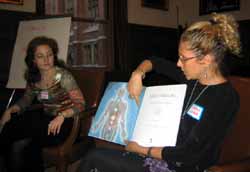Exploring Human Energy Systems in a Non-Traditional Way
A small group of men and women sat in a circle in a classroom in Main Hall one evening in April anxious to learn about the human energy system. Sharon Lamm, who holds a doctorate from TC and a master's degree from Cornell University, and Mirabai Galashan, who has the equivalent of a master's degree from Birmingham University, England, were their teachers in a workshop entitled The Human Energy System and How to Take Care of It. Both women are involved in healing arts, including massage therapy and Reiki, and Lamm is a Certified Intuitive Healer.
Hanging on one wall of the room were seven pieces of paper that represented all the colors of the rainbow. And, as Lamm was to explain shortly, they also represented the seven chakras-the centers of life force energy in the body.
Lamm likened a chakra to a CD disk-"When it runs, it spins well, but sometimes it gets stuck. That is how the chakras work." The definition in Sanskrit, she said, is that it is a wheel of spinning energy.
The seven chakras, located from the crown of the head straight down through the base of the spine, are connected to specific life experiences. For example, the solar plexus chakra, in the upper abdomen under the ribs, relates to inner power and self-esteem, the throat chakra relates to communication. They also affect different parts of the body. For instance, the chakra at the base of the spine can affect the health of feet, legs, colon and spine.
When the chakras are blocked, they said, it becomes evident in our physical health. "What can block energy is often an emotion from some past experience," Lamm said. "Those emotions that you have not felt can get stuck in our system and affect the way our energy system works. When the energy flow is not good, it can affect the choices you make in the present."
Lower back pain, for example, can often be related to issues of not feeling supported or not feeling financially supported, she said.
The colors come in as a part of the unblocking process. Wearing colors that are associated with each chakra can strengthen the energy flow, according to the instructors.
Visualization and certain types of meditation are some of the methods the women described and demonstrated as a means of clearing the chakras and "protecting" one's energy from negative or harmful effects from everyday life. Men and women in the class were also shown how to detect energy fields surrounding each other.
The workshop, given through the Center for Educational Outreach and Innovation's (CEO&I) TC Muses program, is one of a number of nontraditional topics offered to reach out to people interested in participating in innovative and informal experiential learning experiences, according to MaryRose Barranco Morris, Acting Director of CEO&I.
Workshop participant Smadar Taub commented on her interest in the human energy course. "I came to a workshop on meditation a couple of years ago that was very rewarding, and that's what drew me to this workshop," said Taub. "I would like to see more of these kind of programs offered at TC."
Lamm and Galashan are offering the same workshop on the evening of Friday, June 27, and one called Discover Your Life Purpose, the following day.
Other TC Muses offerings include a visit to Staten Island's Snug Harbor Cultural Center for Discovering the 16th and 17th Centuries: A Journey Through the Eyes of a Modern Day Collector. Courses in writing, from creative writing and memoir writing to personal experience pieces and travel writing, will also take place in June and July. These are just a sample of the types of workshops being offered during the summer of 2003. For more information, view the TC Muses web page at www.tc.columbia.edu/ceoi/museweb.
Published Tuesday, Jun. 17, 2003
